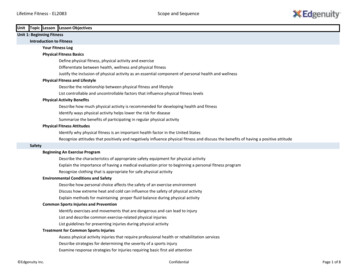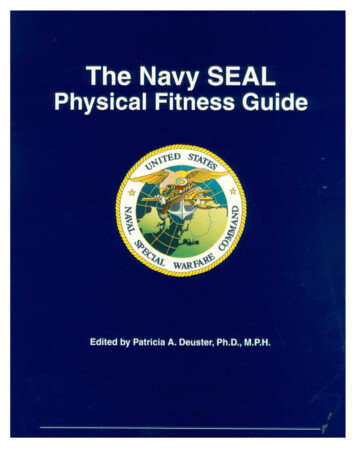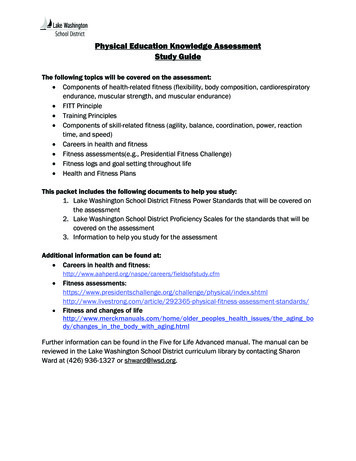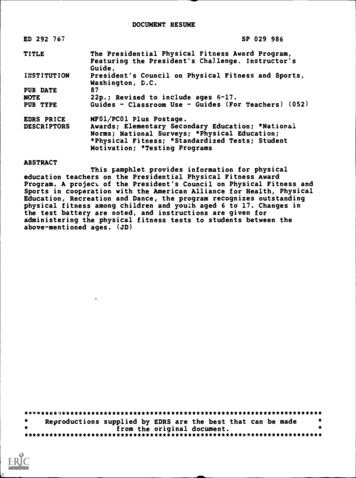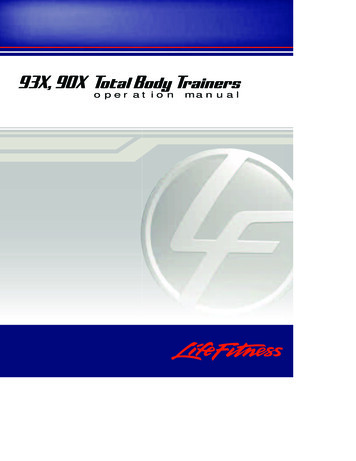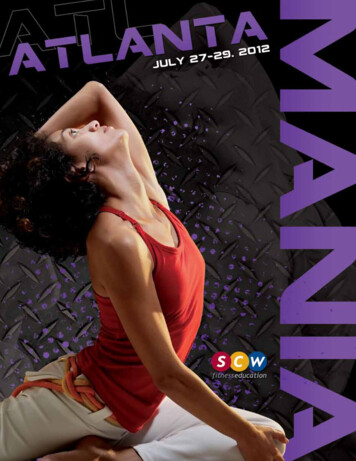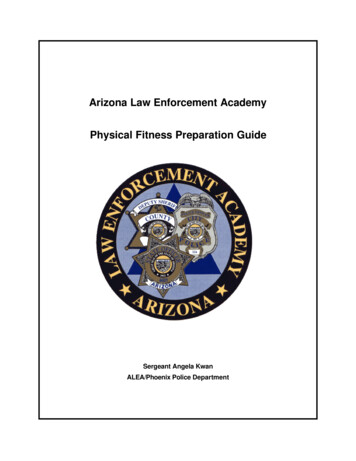
Transcription
Arizona Law Enforcement AcademyPhysical Fitness Preparation GuideSergeant Angela KwanALEA/Phoenix Police Department
Arizona Law Enforcement Academy Physical Fitness Preparation GuideINTRODUCTION:This guide is a resource but targets pre-applicants or those individuals preparing to attend theArizona Law Enforcement Academy (ALEA). Active personnel within the criminal justiceprofession who wish to improve their personal level of physical fitness can also use this guide.Individuals should consult with a medical or health professional before beginning anynew exercise, nutrition, or supplementation program or if any personal health questionsarise after reviewing the contents of this guide.ALEA provides basic peace officer training for a number of law enforcement agencies fromthroughout Arizona. The training and command staff encourages pre-applicants and individualswho have been selected to attend ALEA be provided a copy of this guide. A typical physicalfitness routine for recruits includes an up to four mile run at a 10 minute per mile pace, 20 to 40sit-ups or crunches, 20 to 40 push-ups, 10 to 20 chin-ups, and 10 to 20 dips.ALEA provides recruits with a basic foundation for fitness that includes stretching and exercisetechniques and suggestions on improving cardiovascular endurance. Recruits participate in amoderately strenuous physical conditioning program to prepare for both the occupation and topass the Peace Officer Physical Aptitude Test (POPAT ), the state of Arizona’s mandatedphysical fitness evaluation to become a certified peace officer.Academy Physical Fitness Test ProcessDuring the first week of training and continuing throughout the class schedule, recruitsparticipate in a number of physical fitness events and tests. Recruits who have a solidfoundation in physical fitness or those who have been actively participating in a physical fitnessprogram just prior to entering into recruit training, in most cases, score higher than thoserecruits who have not been active.Physical fitness events and tests include:Cooper / Fit Force Assessment TestCooper/Fit Force Assessments measure health related components to fitness. Components areimportant to quality of life and can determine performance levels (e.g. ability to participate invigorous activity or performing essential job functions).Event #1:1.5 Mile RunThe 1.5-mile run measures cardiovascular endurance. This fitness area is related to performingtasks that may involve sustained activity such as a long foot pursuit followed by a physicalconfrontation (taking someone into custody). The test is conducted on a 440-yard track; one lapequals one-quarter mile/six laps equals 1.5 miles. There is no walking or stopping allowedduring the test.Event #2:One minute Sit-upsSit-ups measure muscular endurance of the abdominal muscles. This fitness area is related toperforming tasks that may involve the use of force and maintaining good posture that minimizelower back problems. Performance sit-ups are not crunches. Recruits lie on a mat with kneesbent and hands behind the head. Another recruit holds the feet down during the test. Therecruit completes as many sit-ups as possible in one minute.2
Arizona Law Enforcement Academy Physical Fitness Preparation GuideEvent #3:Maximum Push-up testPush-ups measure muscular endurance of the upper body muscles to include shoulders, chest,and back of the upper arms. This fitness area is related to the use of force involving pushingmotion. Standard push-ups are continued until failure (e.g. inability to continue due to musclefatigue). Recruits assume a push-up position with feet together or up to twelve inches apart.Hands are placed approximately shoulder-width apart with fingers facing forward. A partnerrecruit is in a position to extend a fist on the floor directly underneath the testing recruit’ssternum. A proper push-up is when the testing recruit lowers the body and touches the fist withthe sternum then returns up to the starting position with the elbows in a soft lock. Proper form isclosely monitored.Event #4:Vertical JumpVertical jumps, the difference between the standing reach and the jumping reach, measureexplosive power. This fitness area is related to operational or pursuit tasks that require jumpingand vaulting. With the use of a Vertec Jump Apparatus a recruit’s standing reach is measuredwith a standard tape measure. Recruits conduct three standing jumps reaching as high aspossible with the highest jump being recorded.Event #5:300-meter RunThe 300-meter run measures anaerobic capacity. This fitness area is related to performingshort intense bursts of effort such as foot pursuits. Recruits sprint 300 meters (approximately ¾of a lap around the track) for this event.Event #6:Agility RunAgility runs measure coordinated movement and speed. This fitness area is related toperformance of tasks requiring quick movements around obstacles. Recruits shuttle throughtraffic cones that have been set up in a 30-foot line as quickly as possible.Event:POPATA passing score of this validated Job Task evaluation is required for graduation. POPATis based on a point score and a minimum of 384 points is required to successfully complete theevent. POPAT is structured into a number of events that have specific scoring criteria. Thetotal sum of all the events is considered for the final score. It is possible to struggle in one areabut excel in another and still pass the test. As an example, the dummy drag requires that arecruit drag a 165-pound dummy 32 feet. Smaller or lighter recruits may not score as high as arecruit who is taller or heavier but the smaller recruit may be faster and more agile thereforeperforming better on the six-foot walls or the 99-yard obstacle course.PREPARATION GUIDE FOR THE PHYSICAL FITNESS TESTThe job of a peace officer requires reasonable levels of cardiopulmonary endurance, muscularstrength, and muscular endurance. The ALEA physical fitness test includes six events thatdetermine the level of a recruit’s fitness based on the Cooper Institute’s law enforcement singlestandard. The test is physically demanding and requires that recruits be reasonably physicallyfit to successfully complete the test. This guide provides direction to prepare recruits andidentify ALEA’s expectations.3
Arizona Law Enforcement Academy Physical Fitness Preparation GuideWhat is physical fitness?Physical fitness is the ability to perform physical activities, such as job tasks, with enoughreserve for emergency situations and to enjoy normal activities when off duty.Major areas of fitness:Major areas of physical fitness include: flexibility cardiopulmonary endurance muscular strength muscular enduranceBody composition is also considered an area of physical fitness. Recruits should note thatexcessive body fat increases the workload placed upon the body and decreases the body'sability to dissipate heat.A proper physical fitness program can be and should be specific for the job of a peace officer.The program should include all of the major areas of physical fitness as noted and be a totalbody program. Although physical fitness improvements may be best accomplished at a gymequipped with an array of weights and fitness machines, this guide includes exercises thatrequire little or no equipment.HydrationProper hydration is critical to proper physical fitness and a requirement at ALEA. All recruitsshould drink water before, during, and after exercise. Recruits are instructed that fluids needample time to saturate the cells of the human body, therefore, they should begin hydrating theday before intense activity. Additionally, recruits are encouraged to drink at least one liter ofwater one hour prior to the test.Warm-up & FlexibilityA warm-up serves several functions, including: increased blood flow to working muscles and joints decreased likelihood of injury decrease in pre-event tension possible improved performance improved flexibilityA proper warm-up includes a few minutes of the same type of activity at a very light exertionlevel. For example, if a recruit is warming up in preparation to go running, the recruit should runin place or for a short distance at a very easy pace.The next step is to stretch with the intent to improve flexibility and continue the warm-upprocess. Stretching includes two phases. The first phase is the easy stretch. Recruits hold thestretch for 10 seconds in a range of motion that produces only mild tension. The second phasedescribed as the developmental stretch requires the recruit to move slightly farther to the pointwhere there is a more tension. Second phase stretches should be held for another 10 seconds.4
Arizona Law Enforcement Academy Physical Fitness Preparation GuideFlexibilityWhen stretching, recruits are directed to follow these basic rules: Stretch slowly No bouncing No pain; stretching should feel good Stretching is not competitive Breathe slowly to help relaxEach stretching sequence should be repeated 2 or 3 times1. Knee to ChestGlutes, Low Back, Hamstrings, Quadriceps Lay flat on back with knees bent. To experience mild tension, grab under right thigh and pullknee toward chest. Hold for 10 seconds, then pull farther to slightly increasetension. Hold this position for 10 seconds. Repeat with other leg.2. Knee to Chest -Leg StraightGlutes, Low Back, Hamstrings, Quadriceps Lay flat on back with knees bent. Grab under right thigh and straighten right leg. Do not lockknee. Hold for 10 seconds, then pull farther to slightly increasetension. Hold this position for 10 seconds. Repeat with other leg.5
Arizona Law Enforcement Academy Physical Fitness Preparation Guide3. Knee to Chest -DiagonalGlutes, Low Back, Hamstrings, Quadriceps, Piriformis Lay flat on back with knees bent. To experience mild tension, grab under right thigh and pullright knee toward left chest. Hold for 10 seconds, then pull farther to slightly increasetension. Hold this position for 10 seconds. Repeat with other leg.4. Leg CrossPiriformis, Glutes, Low Back Lay flat on back with knees bent. Place right outer ankle on the top of right left thigh. To experience mild tension, grab under left thigh andpull left knee toward chest. Hold for 10 seconds, then pull farther to slightly increasetension. Hold this position for 10 seconds. Repeat with other leg.5. Side Quadriceps StretchQuadriceps, Hip Flexors, Abdominals Lay on left side. Grab right shin, just above the right ankle. Slowly pull right foot toward right buttock While pushing right hip forward. At the same time, push right hip forward. Hold for 10 seconds, then pull farther to slightly increase tension. Hold this position for 10 seconds. . Repeat with other leg.6
Arizona Law Enforcement Academy Physical Fitness Preparation Guide6. Butterfly StretchGroin, Low Back Sit upright with the bottoms of feet touching each other. Bend forward at the waist to a position to feel mild tension. To increase stretch, elbows can be used to push down onthighs. Hold for 10 seconds, then pull farther to slightly increasetension. Hold this position for 10 seconds.7. Straddle StretchGroin, Hamstrings, Low Back Sit upright with legs straight. Spread legs as far as comfortable. Keeping legs straight, but not locking knees,bend forward at the waist. Hold for 10 seconds then push down farther to experience slightly more tension. Hold this position for 10 seconds. Return to starting position. Repeat sequence, but this time take chest toward left knee. Return to the starting position and repeat sequence toward right knee.8. Cross Over StretchGlutes, Iliotibial Band Sit with legs straight in front. Bend right leg and cross it over to grab around the outside of rightthigh. To experience mild tension, slowly pull bent right leg toward chest. Hold for 10 seconds then push slightly farther to slightly increasetension. Hold this position for 10 seconds. Return to starting position, switch legs, and repeat sequence.9. Calf Stretch7
Arizona Law Enforcement Academy Physical Fitness Preparation GuideCalves Squat down on ground with right foot slightly in front of left. Grasp right shin and rock forward to feel mild tension. Hold for 10 seconds, then push slightly farther to slightly increasetension. Hold this position for 10 seconds. Repeat sequence on opposite leg.10. Chest StretchChest, Shoulders, Biceps Stand with right shoulder against a wall. Place right palm on the wall. To experience mild tension, slowly turn your body awayfrom the wall Hold for 10 seconds, then twist slightly farther to slightlyincrease tension. Return to starting position and repeat sequence with leftarm.11. Triceps StretchTriceps, Posterior Deltoids Stand upright and extend right arm over head. . Grab right elbow with left hand and place right hand on rightshoulder blade. To experience mild tension, slowly push right elbow backward. Hold for ten seconds, then push farther to slightly increase tension. Return to starting position and repeat sequence with left arm.8
Arizona Law Enforcement Academy Physical Fitness Preparation Guide12. Forearm StretchForearms Stand upright and grab right fingers with left hand. To experience mild tension, slowly fold right wristbackwards. Hold for 10 seconds, then push slightly farther toslightly increase tension. Repeat sequence, this time folding wrist forwards. Return to starting position and repeat sequence with left arm.General Principles of ExerciseTo maximize physical fitness results from a training program, several exercise principles shouldbe incorporated into a fitness program.AdaptationAdaptation means that the human body can adjust to any overload as long as it is done in smallincrements. The amount of progress the body can make depends on the adequate rest,consistency of workouts, adequate nutrition, and genetic makeup.OverloadOverload in an exercise training program means that the training program has caused thehuman body to adapt only when the demands are greater than what the body is accustomed todoing. This definition does not mean that the overload is greater than the maximum, rather thatthe overload is generally greater than 75% of the maximal effort.ProgressionThe principle of progression states that as the body adapts to the exercise program one mustgradually increase the overload to continue to adapt. It is critical that all progressions aregradual and small in nature to prevent over loading the body's ability to recover.SpecificitySpecificity of training is the principle that the body will adapt to whatever exercises it performs.This means that if a person only performs on a bench press, the body will not adapt to sit-ups.Therefore, it may be beneficial to alter personal fitness training to prepare for a morecomprehensive Physical Agility Test.Over-TrainingOver-training identifies the body's need for adequate rest and nutrition following exercise torecuperate before the next exercise session. If a recuperation period is not adequate, overtraining will occur. Signs of over training include increased injury rate, increased resting heart9
Arizona Law Enforcement Academy Physical Fitness Preparation Guiderate, muscle soreness that does not subside after 48 hours, apathy, insomnia, loss of appetite,lack of adaptation to exercise, and loss of strength. Over-training must be avoided.BalanceWhen developing a strength-training program, it is important to balance muscle development byincluding exercises that train all major muscles groups of the body. This means if the chest istrained so must the back. Similarly, if the upper body is trained so must the legs be trained. Ifthis principle is not followed, an imbalance occurs in the joints, and injuries occur.Cardiopulmonary Endurance ProgramCardiopulmonary endurance is the ability of the cardiovascular and respiratory systems todeliver oxygen to working muscles. It consists of both aerobic and anaerobic energy systems.Aerobic FitnessDuring aerobic activities, the intensity of the exercise is low enough for the cardiopulmonarysystem to meet the oxygen demands of the working muscles. Aerobic activities includebicycling, hiking, swimming, climbing stairs, and running when performed at a low enoughintensity.Anaerobic FitnessDuring anaerobic activities, the intensity of exercise is so high that the working muscles demandfor oxygen exceed the cardiopulmonary system's ability to deliver it. Since adequate oxygen isnot available, waste products such as lactic acid accumulate. This type of intense activity canonly be short in duration. An example of an anaerobic activity is sprinting.Cardiovascular Training ProgramAerobic and speed training are two cardiovascular training programs listed within this guide.Both aerobic and speed training complement each other and improve aerobic and anaerobicfitness. This program is designed to specifically improve the 1.5-mile run.Aerobic TrainingA cardiopulmonary endurance program should begin at a level that is considered "moderatelydifficult" but not "difficult." Initial intensity levels should allow recruits to be able to speak duringexercise. During the first four weeks of aerobic training, aerobic endurance will improve.Recruits should warm-up with a slow jog and 10-15 minutes of light stretching and cool downafter the aerobic training with a walk or slow jog and 15-20 minutes of stretching. This programshould be done 3 days per week. Off days should include cross training exercise such asbiking, hiking or swimming or complete rest from exercise.10
Arizona Law Enforcement Academy Physical Fitness Preparation GuideSpeed TrainingSpeed training involves a repeated series of exercise activities interspersed with rest or reliefperiods. Speed training is an excellent exercise for improving both aerobic and anaerobicendurance. Running intervals are performed on a track or a marked course with intensity at arate much higher than the aerobic phase. Once again, recruits should warm-up and cool downproperly when exercising.After setting reasonable goal times for each distance, recruits may keep a log to chart progress.The “true time” will determine the “recovery time” in the speed training exercise. An example isprovided below:WeekDayDistanceRepetitionsRest Ratio*Total DistanceGoal TimeTrue Time(Yards)(# times)# times ery time equals the true time multiplied by the rest ratio. In this case, the recovery timeis 8 minutes and 10 seconds. Use this time to stretch or walk.Using a 440 yard track – one lap equals 440 yards or one-quarter of a mile. The straight-awaysand the curves are 110 yards each.114:05
Arizona Law Enforcement Academy Physical Fitness Preparation GuideAerobic PhaseWeekDayDistanceRepetitionsRelief WalkTotal Distance(Miles)(# times)(Minutes)(Miles)Goal 5151140.511.5222.542533123313True Time
Arizona Law Enforcement Academy Physical Fitness Preparation GuideSpeed Training PhaseWeekDayDistanceRepetitionsRest Ratio*Total DistanceGoal TimeTrue Time(Yards)(# times)# times 530.9531101230.7523413
Arizona Law Enforcement Academy Physical Fitness Preparation GuideMuscular Strength/Endurance ProgramMuscular Strength/Endurance is a resistance program designed to improve total body strengthand endurance. This is not a bodybuilding or a power-lifting program but designed to prepare arecruit specifically for the physical agility test of both hiring processes and the physicalconditioning at the ALEA. Recruits not familiar with lifting programs or recruits that have anyjoint pain or feel uncomfortable performing these exercises should seek the advice andinstruction of a professional trainer.This program is designed to be performed three days a week with four days of rest betweenworkouts. Recruits often make critical mistakes when over training in preparation for thephysical agility test. If a recruit feels the symptoms of over training as explained within thisguide further review of exercise principles is necessary. In addition, consider slowing down theprogression, reducing overload, and allow for adequate rest between workouts.This program should follow the warm-up and stretching program.The program workout is designed to be a circuit workout. Circuit training is a very effective andefficient method to improve muscular strength, muscular endurance and cardiovascularendurance. The workout consists of weight lifting at a station for 10-12 repetitions and thenmoving on to the next exercise station. Rest between exercises should not exceed 30 secondsunless there is discomfort. In cases of discomfort, recruits should determine the need to ceaseactivity if an injury is apparent or suspected. For safety purposes, it is recommended to liftwith a partner and spot each other when necessary.General Safety Tips While Performing Resistance Training Always lift with a partner. Ask for help from an expert if uncertain on proper protocol or operation Progress slowly to avoid injuries. Never show off by attempting to lift more weight than normal. Use proper lifting technique when lifting weight plates and dumbbells. Never drink alcohol or take medications that may cause drowsiness prior to lifting weights. Do not lift too quickly and always be in control of the weights. Always use strict form. Proper technique is more important than the amount of weight lifted. Keep head in a neutral position, looking straight ahead and not upwards or downwards.ProgressionOnly experienced weightlifters should complete more than one cycle through a circuit during aworkout. After the first week and depending on muscle soreness, workouts can increase to twocircuits. After three to four weeks, recruits may increase to three circuits. Although it is notcritical to success, ALEA staff recommends recruits follow the exercises in order. If, recruitsexperience soreness after progressing to a higher level of exercise, a decrease in weight and/orthe number of circuits performed is recommended.14
Arizona Law Enforcement Academy Physical Fitness Preparation GuideWeight Training Circuit Workout1. Seated Leg PressQuadriceps, Hamstrings, Glutes, CalvesSet appropriate weight to overload above muscles but not soheavy as to cause injury or failure.Place feet flat on push platform about shoulder width apartand toes pointed slightly outward. Adjust seat so knees are flexed at 90 degrees. Push weight up while exhaling. Stop just short of locking knees. Keep knees in alignment with feet. Keep head in neutral position.2. DB Military PressDeltoids, Triceps, TrapeziusPick appropriate weight to overload above muscles but not so heavyas to cause injury or failure. Raise two dumbbells to height of shoulders. With palms facing forward, alternate pressing each dumbbellupward toward the ceiling, one at a time. Exhale while lifting. Keep head in neutral position. Using slight leg push is acceptable. Repeat with other arm.15
Arizona Law Enforcement Academy Physical Fitness Preparation Guide3. Lat Pull DownLatissimusdorsi, Rhomboids, Posterior Deltoids, BicepsPick appropriate weight to overload above muscles butnot so heavy as to cause injury or failure. Adjust seat and leg hold to allow full range of motion. Hold bar in chin up grip Pull bar straight down to just below the chin. Exhale while pulling weight down. Maintain proper form; do not bring the bar to the rearof the neck or head. Return to starting position.:.4. DB Split-SquatsGlutes, Quadriceps, Hamstrings, CalvesSelect a light weight not over 10 pounds (many people canstart with no weights at all). Stand with feet together than step backward with onefoot about 26 inches. Keep back straight and arms down at side with headneutral, slowly bend both legs. Lower slowly until the left knee barely touches the floor. Forward leg should remain vertical throughout motionwith knee directly over ankle. If knee tends to moveforward over the toes, adjust back foot further backward. Return to the starting position. Inhale while lowering and exhale while pushing back upinto upright position. Repeat with opposite leg.16
Arizona Law Enforcement Academy Physical Fitness Preparation Guide5. Bench PressPectorals, Deltoids, TricepsPick appropriate weight to overload abovemuscles but not so heavy as to cause injury orfailure. Lie on bench, feet flat on floor. Hold bar with arms shoulder width apart orslightly wider. Lower bar to middle of chest. Push bar up to starting position. Inhale while lowering and exhale while pushing back up. Beginners should use a spotter or a chest press machine6. DB RowLatisimussdorsi, Rhomboids, Posterior Deltoids, Trapezius, BicepsPick appropriate weight to overload above muscles but not so heavyas to cause injury or failure. Standing to right of bench, place left knee on bench and supportupper body with left (non- lifting) arm. Keep head in neutral position. Pull DB from ground into waist area with right arm. Lower DB back to starting position. Avoid twisting at waist. Inhale while lowering weight and exhale while lifting weight. Repeat sequence on opposite side.17
Arizona Law Enforcement Academy Physical Fitness Preparation Guide7. Leg ExtensionQuadricepsPick appropriate weight to overload above muscles but notso heavy as to cause injury or failure. Adjust machine so that backs of knees are against padand back pad is supporting lower back. Extend knees stopping just before the knees lock. Slowly lower weight to starting position. Exhale while pushing weight and inhale while loweringweight.Note: Individuals who have undergone reconstructive knee surgery should not performthis exercise.8. Seated Leg CurlHamstringsPick appropriate weight to overload above muscles but notso heavy as to cause injury or failure. Adjust the back of the seat; the back of the heel shouldrest on the ankle pad Match the knee joint to the pivot point. Lower knee pad into place Flex the knee, keeping hips down Slowly ease the weight to starting position. Inhale while flexing the weight down and exhale whileletting the weight rise.18
Arizona Law Enforcement Academy Physical Fitness Preparation Guide9. DB CurlBiceps, ForearmsPick appropriate weight to overload above muscles but notso heavy as to cause injury or failure. Stand up with knees slightly bent. Begin with arms down at sides. Bend right elbow bringing the dumbbell toward rightshoulder. Slowly lower dumbbell to starting position. Exhale while raising weight and inhale while lowering weight. Repeat sequence on opposite side.10. Triceps ExtensionTricepsPick appropriate weight to overload above muscles but not soheavy as to cause injury or failure. Stand up with knees slightly bent. Place hands on bar about 6 inches apart. Keeping upper arms at sides, extend the elbows until armsare almost straight and bar is at mid-thigh. Slowly return bar to an elbow flexed position at mid-chestlevel. Upper arms should remain in contact with sides. Donot allow elbows to move forward, away from body. Exhale while pushing bar down and inhale while returning barback up.19
Arizona Law Enforcement Academy Physical Fitness Preparation Guide11. Abdominal CurlsAbdominal MusclesSit on ground with knees bent at 90 degrees. Keeping feet flat on floor and hands to the side,slowly curl the torso so the chin approaches thechest. Do not raise torso to more than a 45-degree angleoff the floor. Slowly return to slightly above your startingposition, keeping tension on abdominal muscles at all times. Exhale while curling up and inhale while lowering torso back down.12. SwimmersErector Spinae (Lower back), Glutes Lie face down on ground with feet together. Place arms straight out in front. Move the right arm and left leg up at the same time. As you return the right arm and left leg, move theleft arm and right leg up at the same time. Continue alternating in a moderate cadence.20
Arizona Law Enforcement Academy Physical Fitness Preparation GuideExercises without WeightsAlthough it is easier to improve muscular strength and endurance with weight equipment, it isalso possible to accomplish muscular strength and endurance with some weight free simpleexercises. These exercises require minimum equipment and can be done almost anywhere.Recruits should perform these exercises in a circuit moving from one exercise to the next withminimal rest.Initially, exercise should be in the somewhat hard range. This range means do not exercise tofailure but start by going through the circuit one time and then gradually progress until the circuitcan be completed times in a row with minimum rest.Calisthenics Circuit Workout1. Chair SquatsGlutes, Quadriceps, Hamstrings Stand in front of a sturdy and stable chair with legsshoulder width apart and toes pointing slightly outward. Hold arms straight out in front. Slowly lower the buttocks into the chair. As soon as the slightest contact with the chair, slowlystand back up to the starting position. The head should be keep in a neutral position. Inhale while lowering and exhale while standing up.2. Push UpsPectorals, Deltoids, Triceps, Abdominals, Low BackPlace hands on ground shoulder width apart or slightlymore. Keep feet together and back straight throughout theexercise. Lower the body until the upper arms are at least parallelto the ground. Push up to the initial position by completelystraightening arms. Inhale while lowering and exhale while pushing.21
Arizona Law Enforcement Academy Physical Fitness Preparation Guide3. Split-SquatsGlutes, Quadriceps, Hamstrings, CalvesStand with feet together, then step backward with right foot about 26 inchesbehind the left foot. Keep back straight and arms down at side with head neutral, slowlylower right knee straight down onto the floor. Inhale while lowering and exhale while pushing back upinto upr
Individuals should consult with a medical or health professional before beginning an y new exercise, nutrition, or supplementation program or if any personal health questions arise after reviewing the contents of this guide. ALEA provides basic peace officer training for a number of law enforcement agencies from throughout Arizona.
